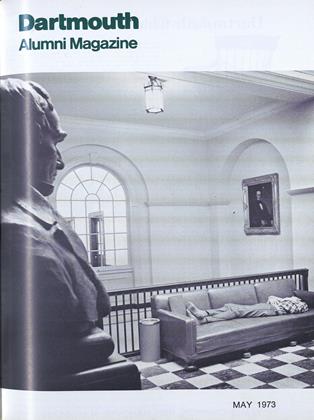With federal support of medical education drastically cut, the question of Dartmouth Medical School financing, and even of continuing the recently adopted full M.D. program, became a matter of major decision for the Dartmouth Trustees at their annual spring meeting, April 12-14.
As reported to the College by President Kemeny in a radio talk and interview over WDCR, the Trustees reaffirmed their decision to offer a "quality three-year medical curriculum leading to the M.D. degree" despite the financial crisis created by the government.
At the same time, the Board authorized initiation of a "selective fund-raising effort to insure the future financial solvency of the Dartmouth Medical School," provided that three prior actions are taken.
Although he did not spell out the total amount to be raised to cover projected Medical School costs following federal cutbacks, President Kemeny said the school would need to raise between $1-million and $1.5 million in new funds each year over current income for an indefinite period, or, alternatively, to obtain the funds as income from large endowment gifts.
To assure the success of the program, the Trustees called for implementation of three actions prior to the start of any fundraising effort.
Stressing that "the M.D. program must operate within a true Medical Center," the Board voted that "therefore an effective functioning relationship must be worked out amongst the Dartmouth Medical School, the Mary Hitchcock Memorial Hospital, and the Hitchcock Clinic, which must result in a unification of the clinical faculty."
Although tightly interrelated in their operations, the three institutions historically have been separate, independent agencies. The clinical faculty of the Medical School consists of those doctors who teach the practice of medicine with patients, and many are also members of the medical staffs of the hospital, clinic or both.
To underscore the urgency of unsnarling the years-old administrative tangle, the Dartmouth Board in its resolution said it "requires a recommendation (for unification) from the Center Planning Committee to its constituent bodies by the June trustee meeting . . . and further expects that the new relationship will be implemented by fall."
As a second condition, the Board said that "the Medical School faculty must accept the limitations on faculty size and budget" recommended by a Medical School Survey Committee, which had asked for authorization to "assume longrange support for a core faculty of 53 fulltime faculty members or their equivalent."
Additional faculty would have to be supported, according to the recommendation accepted by the Trustees, either through research sponsored by the government or other agencies or through service income. It was estimated that, by means of all sources of funding, the Medical School
 View Full Issue
View Full Issue
More From This Issue
-
 Feature
FeatureWhat's So New About It?
May 1973 By Joanna Sternick, A.M. '72 -
 Feature
FeatureLAND OF LOVE
May 1973 By Ralph J. Fletcher '75 -
 Feature
FeatureSCOPE: Off-Campus Options Made Easier
May 1973 By MARY ROSS -
 Article
ArticleThe Indian Yell Revisited
May 1973 By Russell O. Ayers '29 -
 Article
ArticleFaculty
May 1973 By ROBERT B. GRAHAM '40 -
 Article
ArticleHis Own Man
May 1973 By DERO A. SAUNDERS '35







